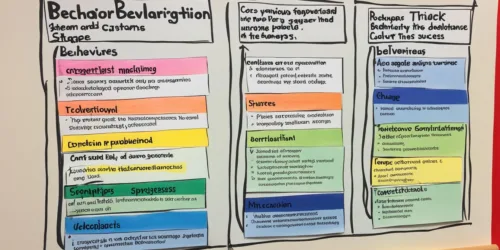Unleash the Power of Emotional Contagion with Us Today!
Welcome to our blog! Here, we explore the fascinating world of emotional contagion and how it can enhance our lives. Emotional contagion refers to the phenomenon where emotions spread between individuals, influencing their mood and behavior. It’s like a contagious wave of emotions that can create a ripple effect of shared emotional experiences, impacting our personal relationships, teamwork, and leadership. At [Your Company Name], we believe in harnessing the power of emotional contagion to cultivate stronger emotional connections, influence the emotions of others, and foster a more positive and productive environment.
Key Takeaways:
- Emotional contagion can influence our mood and behavior
- It has a significant impact on personal relationships, teamwork, and leadership
- Leaders play a crucial role in setting the emotional tone for their teams
- Understanding empathy and emotional mimicry helps us navigate emotional contagion
- Strategies for managing emotional contagion include mindfulness, labeling emotions, and embodying positive emotions
The Impact of Emotional Contagion in Leadership
In leadership roles, emotional contagion becomes even more consequential. Leaders act as emotional barometers, setting the tone for those around them. Their emotions can have a profound influence on the emotions of their team members. Research has shown that leaders who display positive emotions, such as optimism and enthusiasm, can rally their teams behind a shared sense of mission and foster creativity and innovation. On the other hand, leaders who focus on problems and exhibit negative emotions can bring down the morale of the entire organization. It is crucial for leaders to be aware of their own emotions and actively manage them to create a positive emotional climate.
The Power of Emotional Expression
Leaders who model emotional intelligence by expressing their emotions authentically and appropriately can have a significant impact on their teams. By openly demonstrating their feelings, leaders create a safe space for their team members to do the same, fostering trust, empathy, and connection. When leaders express positive emotions, it can uplift the mood of the entire team and enhance collaboration and cooperation. On the other hand, expressing negative emotions without effective regulation can create a toxic work atmosphere and hinder productivity.
The Importance of Emotional Well-being and Awareness
Emotional well-being is vital for effective leadership and can be cultivated through self-awareness and self-care practices. Leaders who prioritize their own emotional well-being can better manage their emotions and provide a positive example for their teams. Additionally, leaders with a high level of emotional awareness can accurately perceive and understand the emotions of others, allowing them to respond empathetically and provide the necessary support. Developing emotional intelligence and a deep understanding of emotional contagion can empower leaders to create a positive work environment that promotes growth, well-being, and success.
Emotional contagion is a powerful force in leadership that can shape the culture of an organization and impact the overall performance of a team. By recognizing the impact of emotional contagion and actively managing our own emotions, leaders can create a positive and productive environment that inspires and motivates their teams to achieve remarkable results.
Understanding Emotional Contagion: The Science Behind It
Emotional contagion, the spreading of emotions from one person to another, operates through various mechanisms that contribute to the formation of emotional bonds. Two important mechanisms are empathy and emotional mimicry. Empathy allows individuals to understand and share the emotions of others, fostering a sense of emotional connection. When we observe someone expressing a particular emotion, our own facial muscles may unconsciously mirror their expression, leading to a shared experience of that emotion. This process of emotional mimicry contributes to the spread of emotions and the strengthening of emotional bonds.
Empirical evidence supports the role of these mechanisms in emotional contagion. Research has shown that when individuals witness others experiencing positive emotions, such as joy or gratitude, they are more likely to experience those emotions themselves. Similarly, observing others’ negative emotions, like sadness or anger, can lead to a contagion effect, where individuals also begin to experience those negative emotions.
Understanding these mechanisms can help us navigate and respond to emotional contagion more effectively. By recognizing how empathy and emotional mimicry contribute to the spread of emotions, we can develop strategies to manage our own emotional well-being and influence the emotional states of others. It also highlights the importance of creating an emotionally positive environment, as positive emotions can spread and contribute to better overall emotional well-being.
Strategies for Managing Emotional Contagion
Emotional contagion is a powerful force that can significantly impact our emotional well-being and the dynamics of our relationships. It is essential to develop strategies to effectively manage emotional contagion in order to create a positive and supportive environment. Here are some practical techniques that can help:
1. Practice Self-Awareness:
Being aware of our own emotions is the first step in managing emotional contagion. Take time to tune in to your feelings and recognize how they may be influencing your behavior and interactions with others. Mindfulness techniques, such as meditation or deep breathing exercises, can help in developing self-awareness and staying present in the moment.
2. Label Your Emotions:
When we label our emotions, we gain a better understanding of them and can create emotional distance. Instead of getting overwhelmed by negative emotions, try to identify and name them. This practice allows us to view our emotions as transient states rather than permanent identities, making it easier to regulate and manage them effectively.
3. Utilize Emotional Release Techniques:
Writing about our emotions in a journal can be a powerful tool for processing and releasing negative emotions. Putting our thoughts and feelings on paper allows us to gain perspective and alleviate the emotional burden. Additionally, engaging in physical activities such as exercise or engaging in creative outlets like art or music can also serve as effective emotional release techniques.
By implementing these strategies, we can better manage emotional contagion and create a positive emotional climate. It’s important to remember that emotions are contagious, and by consciously taking steps to regulate our own emotions, we can influence the emotions of those around us in a positive way.

| Strategies for Managing Emotional Contagion | Benefits |
|---|---|
| Practice Self-Awareness | Gain a better understanding of your emotions and their impact on your interactions with others |
| Label Your Emotions | Create emotional distance and view emotions as temporary states |
| Utilize Emotional Release Techniques | Process and release negative emotions through writing, physical activities, or creative outlets |
The Risks of Negative Emotional Contagion
While emotional contagion can have positive effects, it is important to recognize the risks associated with negative emotional contagion. Negative emotions, such as anger, fear, and sadness, can spread quickly and contaminate the emotional environment. Exposure to toxic emotions from others can lead to a ripple effect of negativity, impacting the well-being of individuals and the overall atmosphere of a group or organization. Being aware of the potential for negative emotional contagion and actively working to counteract it is essential for maintaining a healthy emotional climate.
Research has shown that negative emotional contagion can have detrimental effects on individuals and groups. A study conducted by Smith and colleagues (2018) found that exposure to negative emotional contagion in the workplace led to decreased job satisfaction, increased stress levels, and lower productivity. The negative emotions spread from one team member to another, creating a cycle of negativity that permeated the entire team and affected their overall performance.
To mitigate the risks of negative emotional contagion, it is important to cultivate emotional awareness and regulation. Encouraging open communication and creating a safe space for individuals to express their emotions can help prevent the amplification and spread of negative emotions. Additionally, promoting a culture of support and empathy can help individuals cope with negative emotions and prevent them from infecting others.
| Effects of Negative Emotional Contagion | Strategies to Counteract Negative Emotional Contagion |
|---|---|
| Decreased job satisfaction | Encouraging open communication |
| Increased stress levels | Promoting a culture of support and empathy |
| Lower productivity | Cultivating emotional awareness and regulation |
By actively addressing and managing negative emotional contagion, we can create a healthier and more positive emotional climate. This not only benefits individual well-being but also enhances team dynamics and overall organizational performance. Together, let us strive to counteract negative emotional contagion and promote emotional well-being in all aspects of our lives.
Conclusion
Emotional contagion is a remarkable phenomenon that holds the power to shape our relationships, influence our moods, and profoundly impact our overall emotional well-being. By understanding the mechanisms and effects of emotional contagion, we can harness its power to create positive change in our personal and professional lives.
Cultivating emotional awareness is key. By being mindful of our own emotions and actively managing them, we can navigate the intricate terrain of emotional contagion more effectively. Practicing self-regulation, such as labeling our emotions and writing about them in a journal, allows us to process and release negative emotions, fostering a healthier emotional climate.
Building positive emotional connections is equally important. By embodying positive emotions through our body language and demeanor, we not only shift our own emotional state but also influence the emotions of those around us. Building a culture where empathy and connection thrive brings us closer to creating a world where emotional well-being is prioritized.
Let us embrace the art of emotional contagion and unleash its transformative potential. Together, we can create a world where empathy, connection, and positive emotions flourish, nurturing our collective emotional well-being.
FAQ
What is emotional contagion?
Emotional contagion refers to the phenomenon where emotions spread between individuals, influencing their mood and behavior.
How does emotional contagion impact leadership?
Leaders act as emotional barometers and their emotions can have a profound influence on their team members. Positive emotions can foster creativity and innovation, while negative emotions can bring down morale.
What are the mechanisms behind emotional contagion?
Emotional contagion operates through mechanisms such as empathy, which allows individuals to understand and share the emotions of others, and emotional mimicry, which is the unconscious imitation of others’ emotional expressions and behaviors.
How can I manage emotional contagion?
Practicing mindfulness, labeling our emotions, and writing in a journal can help manage emotional contagion. Additionally, embodying positive emotions through body language can influence our own emotional state and the emotions of those around us.
What are the risks of negative emotional contagion?
Exposure to toxic emotions can lead to a ripple effect of negativity, impacting the well-being of individuals and the overall atmosphere of a group or organization.






